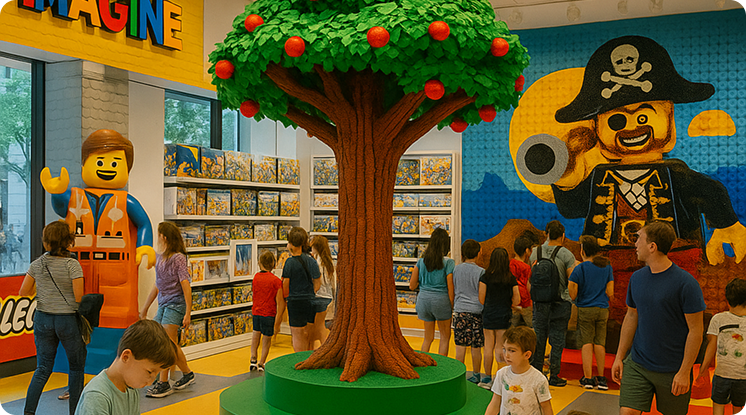
Experiential Flagships:
Turning Stores into Story scapes
Experiential Flagships:
Turning Stores into Story scapes

Let’s be honest, people don’t need to visit stores anymore. They choose to. And if they’ve chosen you, the question is: what are you giving them in return?
For many leading brands, the answer has been: an experience worth remembering.
Flagship stores today are less “shops” and more storyscapes, immersive playgrounds where customers can step into a brand’s world. The transaction becomes almost secondary. What lingers is the memory.
Take Nike Paris. Instead of a typical store, you enter a space buzzing with digital walls, activity zones, and AR games. Shoppers aren’t just browsing; they’re chasing hidden easter eggs, competing in mini sports challenges, and sharing scores online. Suddenly, a retail visit becomes a gamified adventure.
Or think LEGO’s New York flagship, where families co-create massive brick mosaics displayed instantly on giant screens. The magic isn’t in the purchase, it’s in the pride of seeing your creation come alive in-store.
Even luxury has embraced this. Burberry’s “social retail” store in Shenzhen uses a WeChat mini program to gamify every corner, from themed fitting rooms to social rewards for exploration. Gucci turned its flagship into part museum, part theater.
Why does this work? Because people crave stories, not shelves. A flagship that feels like a gallery, a playground, or a cultural hub creates emotional stickiness no e-commerce platform can.
We see flagship design as stagecraft. Every element, the lights, the screens, the staff, even the scent in the air, is part of the script. When done right, visitors walk out not just with a bag in hand, but with a story to tell. And in today’s social-driven world, that story is often shared, reposted, and multiplied.
Experiential flagships aren’t expenses. They’re investments in memory, culture, and loyalty. And in retail, those are the currencies that matter most.
Let’s be honest, people don’t need to visit stores anymore. They choose to. And if they’ve chosen you, the question is: what are you giving them in return?
For many leading brands, the answer has been: an experience worth remembering.
Flagship stores today are less “shops” and more storyscapes, immersive playgrounds where customers can step into a brand’s world. The transaction becomes almost secondary. What lingers is the memory.
Take Nike Paris. Instead of a typical store, you enter a space buzzing with digital walls, activity zones, and AR games. Shoppers aren’t just browsing; they’re chasing hidden easter eggs, competing in mini sports challenges, and sharing scores online. Suddenly, a retail visit becomes a gamified adventure.
Or think LEGO’s New York flagship, where families co-create massive brick mosaics displayed instantly on giant screens. The magic isn’t in the purchase, it’s in the pride of seeing your creation come alive in-store.
Even luxury has embraced this. Burberry’s “social retail” store in Shenzhen uses a WeChat mini program to gamify every corner, from themed fitting rooms to social rewards for exploration. Gucci turned its flagship into part museum, part theater.
Why does this work? Because people crave stories, not shelves. A flagship that feels like a gallery, a playground, or a cultural hub creates emotional stickiness no e-commerce platform can.
We see flagship design as stagecraft. Every element, the lights, the screens, the staff, even the scent in the air, is part of the script. When done right, visitors walk out not just with a bag in hand, but with a story to tell. And in today’s social-driven world, that story is often shared, reposted, and multiplied.
Experiential flagships aren’t expenses. They’re investments in memory, culture, and loyalty. And in retail, those are the currencies that matter most.
